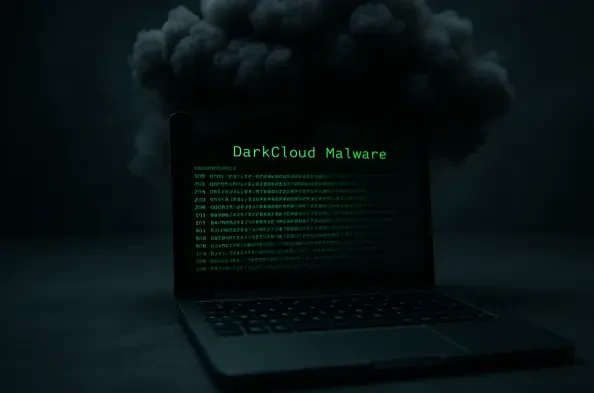In the rapidly shifting world of cybersecurity, a chilling new threat has surfaced that exploits trust in the most deceptive way, making it a significant concern for individuals and organizations alike. Picture this: an email lands in a company inbox, disguised as an urgent banking notification, complete with a seemingly harmless attachment that promises critical financial details. Unbeknownst to the recipient, clicking on it unleashes DarkCloud malware, a vicious infostealer capable of harvesting everything from passwords to cryptocurrency assets. Uncovered in September by a leading managed detection and response provider, this spear-phishing campaign targeted a mid-sized manufacturing firm, revealing just how cunningly cybercriminals manipulate human behavior to infiltrate systems. This incident serves as a stark reminder of the sophistication of modern cyber threats, where personalized attacks can bypass even robust defenses. Delving into the mechanics of DarkCloud and its delivery through phishing offers crucial insights into the evolving dangers businesses face and the urgent need for heightened vigilance.
Unmasking the Deceptive Entry: Spear-Phishing Tactics
Spear-phishing stands out as a particularly insidious method of attack, far removed from the scattershot approach of generic spam emails. It’s a tailored strike, meticulously designed to deceive a specific individual or organization by leveraging personal or contextual details. In the case of the manufacturing company targeted by DarkCloud, the attackers sent an email masquerading as a banking communication, complete with a subject line referencing a “Swift Message MT103 Addiko Bank.” Originating from a dubious domain, the email carried a ZIP file attachment that, once opened, deployed a malicious executable identified as DarkCloud version 3.2. This carefully crafted lure capitalized on the routine nature of financial correspondence in business settings, exploiting the likelihood that an employee in a support role would interact with the attachment without suspicion. Such precision in targeting underscores how attackers research their victims to maximize the chances of success, turning everyday digital interactions into potential entry points for devastating malware.
The implications of this spear-phishing strategy extend beyond a single incident, highlighting a broader vulnerability in organizational security. Employees often handle numerous emails daily, many of which appear legitimate at first glance, especially when tied to familiar themes like banking or client transactions. The DarkCloud campaign’s use of a ZIP file to conceal its payload further complicates detection, as compressed files can evade basic email filters that fail to inspect their contents thoroughly. This tactic reveals a calculated effort to exploit not just technological gaps but also the inherent trust placed in digital communication. As businesses increasingly rely on email for critical operations, the risk of falling prey to such personalized deception grows, necessitating a deeper understanding of how these attacks are structured. Recognizing the hallmarks of spear-phishing—urgent tones, unexpected attachments, and unfamiliar senders—becomes a vital first step in preventing malware like DarkCloud from gaining a foothold in sensitive systems.
Inside the Threat: DarkCloud’s Data Theft Capabilities
DarkCloud malware emerges as a formidable adversary once it infiltrates a system, showcasing an alarming array of tools designed for comprehensive data theft. This infostealer is programmed to extract a wide spectrum of sensitive information, including browser-saved passwords, credit card numbers, keystrokes, email contacts, and even cryptocurrency wallets such as MetaMask and Exodus. Beyond merely collecting data, it employs multiple channels like Telegram, FTP, and SMTP to exfiltrate stolen information to remote servers controlled by attackers, ensuring swift monetization of compromised assets. Marketed on underground platforms and disguised as legitimate tools under handles like @BluCoder, DarkCloud has evolved over time, transitioning to frameworks like Visual Basic 6 while incorporating advanced features to maximize its reach. Its ability to target specific file types—think PDFs or spreadsheets—further amplifies the potential damage, making it a prized weapon for cybercriminals seeking high-value data.
What sets DarkCloud apart is not just its theft capabilities but also its sophisticated methods for evading detection and maintaining persistence. The malware uses string encryption through techniques like the Caesar cipher to obscure its code, complicating efforts by security analysts to dissect its operations. Additionally, it employs sandbox evasion tactics, halting execution if it detects monitoring tools like Wireshark or if system conditions suggest a virtual environment. Persistence is achieved through randomized registry entries, ensuring the malware reactivates after system reboots. These features collectively paint a picture of a meticulously engineered threat that doesn’t just steal but actively works to remain hidden within infected systems. For organizations, this dual nature of aggression and stealth poses a significant challenge, as traditional antivirus solutions often struggle to identify and neutralize such well-disguised malware before substantial harm is done.
The Human Factor: Social Engineering as a Weapon
At the heart of the DarkCloud phishing campaign lies a powerful psychological tactic known as social engineering, where attackers manipulate human behavior to achieve their goals. The email lure in this incident was deliberately crafted to appear as an urgent banking notice, a theme likely to prompt immediate attention from employees handling financial or support tasks. By mimicking the format and urgency of legitimate correspondence, cybercriminals exploit the natural inclination to act quickly on critical matters, often bypassing rational scrutiny of the email’s authenticity. This approach doesn’t rely on brute force or technical exploits alone but rather on the predictable responses of individuals under pressure, demonstrating how even the most secure systems can be undermined by a single moment of misplaced trust or curiosity.
The broader lesson from this reliance on human vulnerability is that technology alone cannot fully safeguard against such threats. Employees, particularly those in roles involving frequent external communication, become prime targets due to their exposure to unsolicited messages that may seem relevant to their duties. The DarkCloud attack illustrates how attackers leverage context—such as industry-specific terminology or transaction references—to lower defenses, making the phishing attempt appear credible. This underscores a critical gap in cybersecurity: the need to address the human element as rigorously as the technological one. Without consistent training to recognize suspicious patterns, like unexpected urgency or unfamiliar attachments, staff remain the weakest link in the security chain, inadvertently providing attackers with the access needed to deploy devastating malware.
Building Strong Defenses: Strategies to Combat DarkCloud
Countering a threat as cunning as DarkCloud requires a multifaceted defense strategy that addresses both technical and behavioral vulnerabilities. The rapid response by the managed detection team in this case—quarantining malicious emails and blocking the executable before it could execute—proved instrumental in preventing widespread damage to the targeted company. This highlights the importance of continuous, round-the-clock monitoring to catch threats in real-time, especially given the speed at which malware can spread once activated. Recommendations from security experts include implementing strict email policies to block ZIP attachments containing executables, a common delivery method for infostealers. Deploying advanced endpoint detection and response tools also adds a layer of protection by identifying and isolating suspicious activity on devices, ensuring that even if a phishing attempt succeeds, its impact can be contained.
Beyond technological safeguards, fostering a culture of awareness within organizations is equally vital to thwarting attacks like DarkCloud. Phishing and security awareness training programs play a crucial role in equipping employees with the skills to spot deceptive emails, such as those with urgent tones or unexpected attachments from unknown sources. This educational approach tackles the root of social engineering by empowering staff to act as the first line of defense, reducing the likelihood of falling for tailored lures. Combining such training with partnerships with managed detection and response services ensures a comprehensive shield against evolving threats. As cybercriminals continue to refine their tactics, blending human manipulation with technical prowess, businesses must adapt by integrating robust tools and informed personnel, creating a resilient barrier against the persistent danger of data theft through phishing campaigns.
Looking Ahead: Strengthening Cybersecurity Resilience
Reflecting on the spear-phishing campaign that unleashed DarkCloud malware, it’s evident that cybercriminals exploited both technological loopholes and human tendencies with alarming precision. The incident served as a critical reminder of how tailored email lures, paired with advanced infostealers, could penetrate even well-guarded systems. Security teams acted swiftly to mitigate the threat, underscoring the value of proactive monitoring and immediate response. Moving forward, organizations must prioritize actionable steps like enforcing stringent email filtering to block risky attachments and investing in next-generation antivirus solutions. Equally important is the ongoing education of employees to recognize and resist social engineering tactics. By fostering collaboration with expert security providers for continuous threat hunting, businesses can stay a step ahead of evolving dangers, ensuring that lessons from past attacks translate into stronger, more adaptive defenses against future cyber threats.






